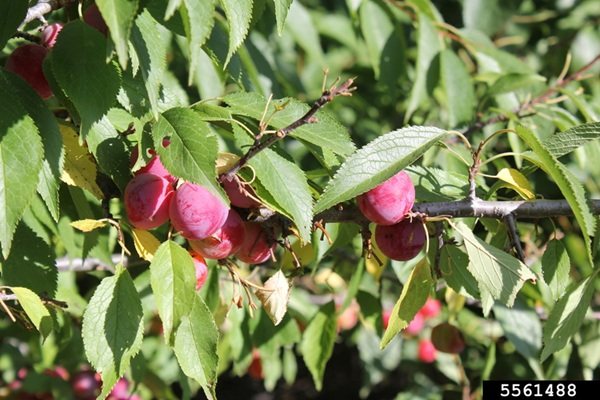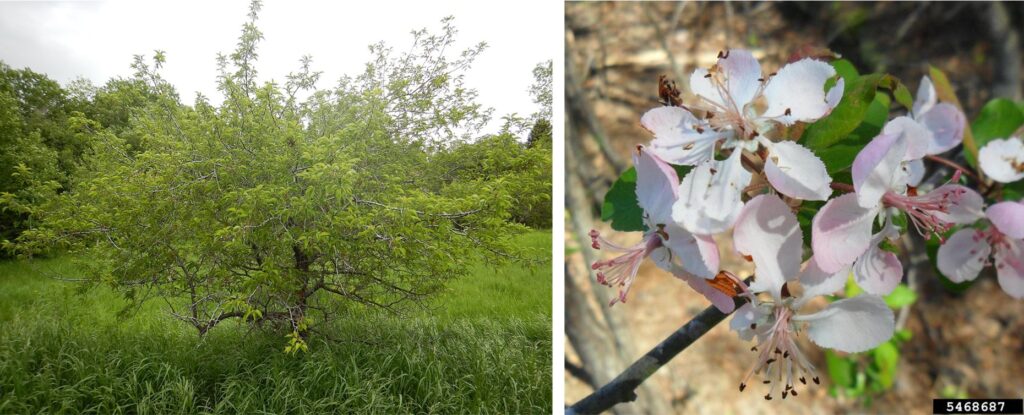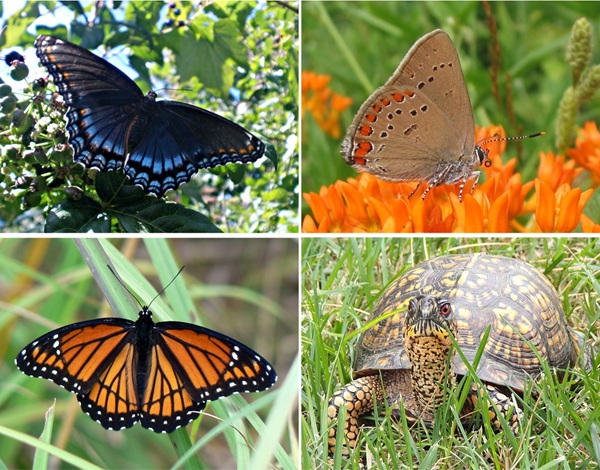
At a glance:
- Soil needs: Typically said to prefer loamy well-drained soils, but also noted to do well on stream banks. Prefers neutral to slightly-acidic pH.
- Water needs: Medium water needs. Benefits from regular waters for first year after planting.
- Sun needs: Full sun for best harvest, but will happily tolerate partial shade.
- Size needs: Small tree/large shrub. Max height 10 to 20ft. Can form thickets via suckers if allowed to.
- Growth rate: Moderately fast, 2-3 feet per year, until fruiting begins. Then vertical growth slows, and plant concentrates more on sending out suckers.
- Tolerates Black Walnut: Yes, this tree can be planted near Black Walnut.
- Wildlife value: Extremely high. Prunus (plums and cherries) is second only to Quercus (oaks) in terms of the number of insects it supports. The flowers are also beloved by native bees, and the plums are eaten by small mammals and reptiles.
A bit more…
American plum (Prunus americana) is another one of my favorite trees. Everything about it is beautiful. Its flowers are beautiful, its fruit is beautiful, the tree itself is beautiful, the insects it attracts are beautiful… heck, even its history is beautiful! I have four of them on my property. What drew me to them was a combination of the incredible number insects they support, as well as the fact that they are often used to stabilize creek banks (something I am trying to do). It also doesn’t hurt that I really, REALLY like plums. None of mine have fruited yet, so I don’t actually know how they taste. I have heard that “wild” American plums have a wide range of taste, from delicious to fairly sour. However, I don’t think I’ll mind even if they’re pretty sour — they will still make some great jam no matter what!

When I first decided I wanted to plant some, I was initially discouraged by the recommended soil type: “well-draining loam.” Parts of my property can be fairly waterlogged at time, and I certainly don’t have loam — I have thick clay. But I also found various websites which mention that Prunus americana can tolerate poor-draining soil types. While it wasn’t the majority of websites, they were high quality sources, for instance the USDA National Resources Conservation Service. Coupled with the fact that many sites mention using it for stream erosion control (which does not imply “well-draining” to me!), I decided to give it a go. I’m happy to report that the plum trees are thriving on my property!

One warning I repeatedly came across was that thriving American plums can put out many suckers, and quickly turn into thickets. They most be pruned and trained starting from a young age if you want to ensure that they become a single-stemmed tree. While that is not overly hard to do, I think it’s also worth nothing that, in my opinion, the tendency to form thickets is a benefit, not a drawback! If you are trying to stabilize creek banks (which I am), then it just means they’ll do the job faster and do the job better. If you are excited about eating some plums (which I am), then it just means you will have bigger plants giving you more and more fruit. And if you are trying to rewild your land and provide food for native insects (which I am), then it just means you will be giving them more leaves to much on. So I am actively hoping that mine do turn into thickets!

As far as the insects they support — it is a lot! The genus Prunus supports more native insect than any other genus besides Quercus (oaks). It is worth noting that there can be a lot of overlap between the different Prunus members. So if you have a lot of black cherry trees (Prunus serotina), then planting an American plum may not net you the same influx of new bugs as someone who doesn’t (but is of course still valuable to do). This gets back to the idea that having the maximum variety of native species within the vicinity will lead to the most productive ecosystem, so it is always worth considering what trees you already have nearby. But any native tree is better than none!

Just as a few examples, the American plum supports the coral hairstreak butterfly (Satyrium titus), the red-spotted purple butterfly (Limenitis arthemis), and the viceroy butterfly (Limenitis archippus) – a stunning monarch lookalike that is a common favorite. It supports many moths, such as American plum borer (Euzophera semifuneralis), American dagger moth (Acronicta americana), and various sphinx moths (Sphingidae). American plums will bring some bigger friends to your yard too. Both gray and red fox have been known to eat the plums, as well as box turtles! Who doesn’t want some cute turtles coming into your yard to much on some fruit?!
I also mentioned previously that even the history of Prunus americana is beautiful. By that, I was alluding to how intertwined the tree is with various indigenous American cultures, from the northeast, through the plains, and all the way to southwest. The Navajo used its roots to create a red dye for clothing. The Cheyenne used its branches in their ceremonial Sun Dance. And a great many tribes planted it extensively for sustenance. American plum is great choice because it’s such a heavy-hitter when it comes to supporting the native ecosystem, but it also a great choice because of its long and deep history with the people of North America.
